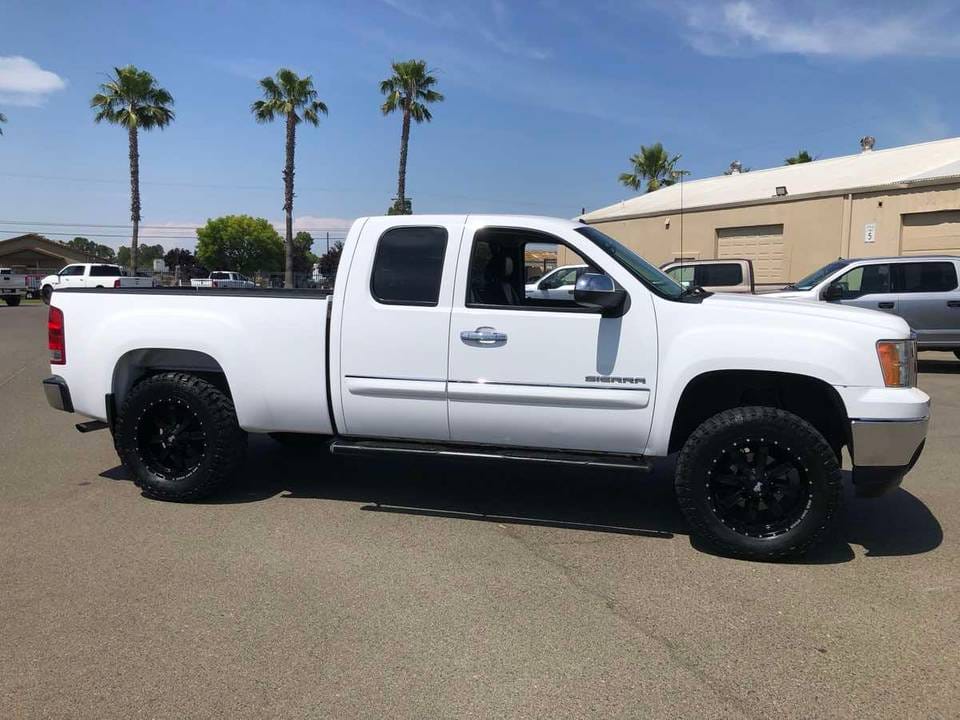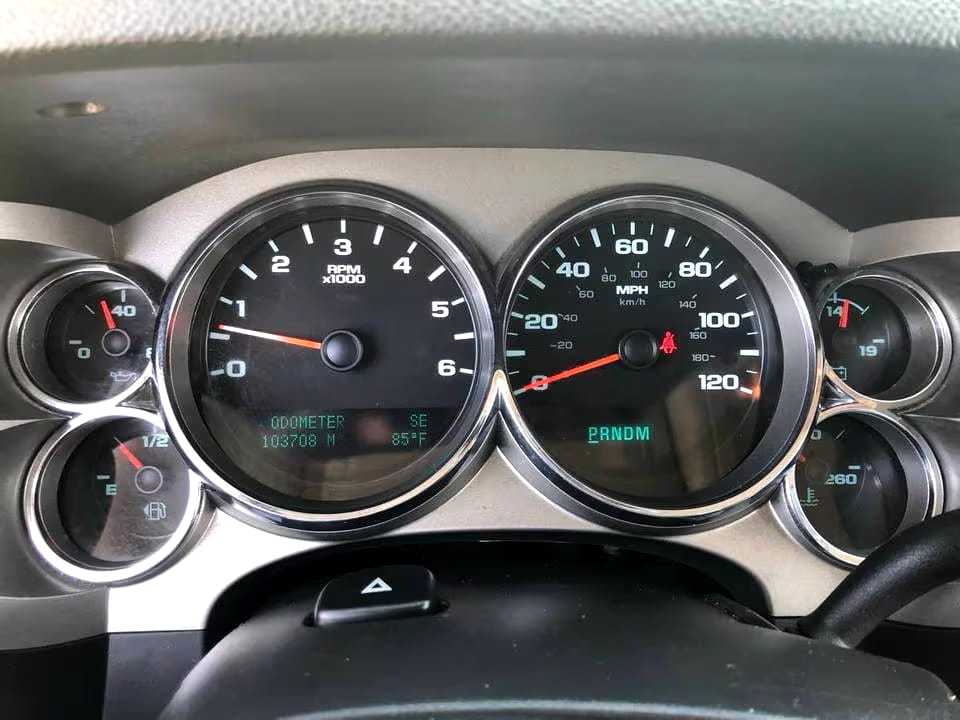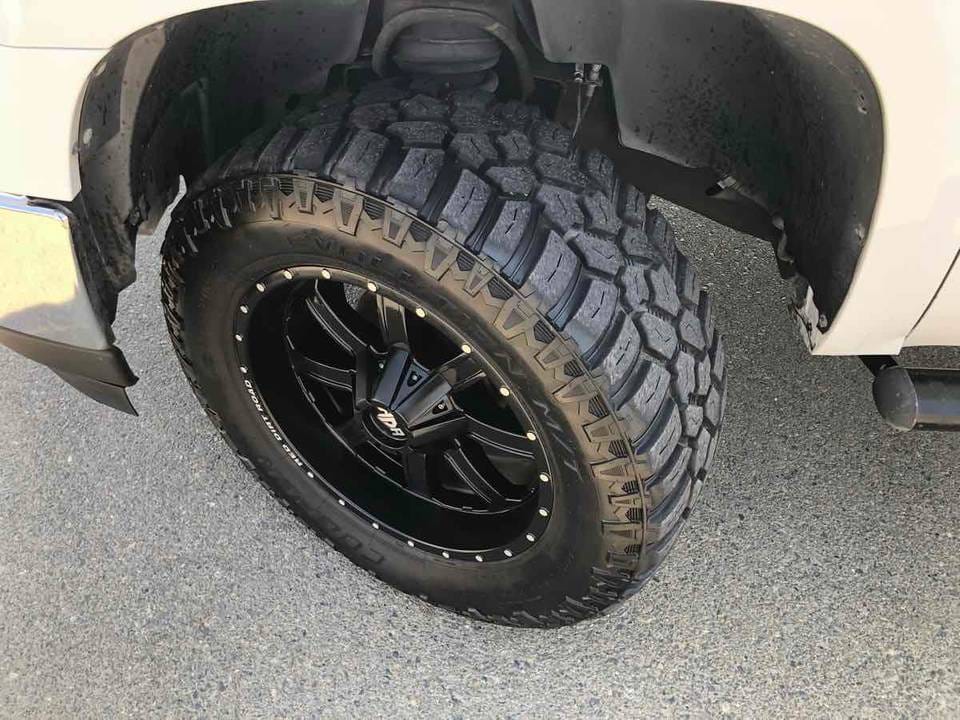2013 GMC SIERRA DOUBLE CAB – Certified Pre-Owned
In Stock
£5,400.00
2013 GMC SIERRA
Vehicle Summary Mileage 106,560 Ext. Color Exterior Color Summit White Int. Color Interior Color Jet Black Cloth Engine Flex-Fuel (FFV) Transmission Automatic Drivetrain Rear Wheel Drive MPG 18/24 City/Hwy MPG 20 Combined MPG Horsepower 355 hp Max Towing Capacity 9,300 lbs Standard Payload Capacity 2,088 lbs Bed Length 6'7” Seats 3
2013 GMC SIERRA
Vehicle Summary
Mileage 106,560
Ext. Color Exterior Color Summit White
Int. Color Interior Color Jet Black Cloth
Engine Flex-Fuel (FFV)
Transmission Automatic
Drivetrain Rear Wheel Drive
MPG 18/24 City/Hwy MPG
20 Combined MPG
Horsepower 355 hp
Max Towing Capacity 9,300 lbs
Standard Payload Capacity 2,088 lbs
Bed Length 6’7”
Seats 3
USED 2013 GMC SIERRA DOUBLE CAP
VIN 1GTN1UEC3EZ251479
2013 gmc sierra 1500 specs, 2013 gmc sierra 1500 denali, 2013 gmc sierra 1500 hybrid, 2013 gmc sierra 1500 slt
FAQ
What year Sierra is most reliable?
How many miles will a 2013 GMC Sierra 1500 last?
What year GMC Sierra has transmission problems?
Is a 2013 GMC Sierra a good truck?
The GMC Sierra 1500 is virtually identical to the Chevrolet Silverado 1500, and yet there’s something that keeps a certain kind of shopper coming back for the GMC version of this full-size pickup.
Whether it’s the allure of the GMC badge, the working-man imagery at GMC’s roots, or its subtle trim differences, some people simply prefer the Sierra. Along with the Silverado, the Sierra takes on the Ford F-150 and Ram 1500 in vying for truck traditionalists.
Although last redesigned in 2007—and without any serious design changed since then—the Sierra is still one of the better choices for truck buyers of all kinds, from commercial users to personal-luxury seekers, thanks to a wide variety in powertrains, pleasant handling, and titanic towing capacity.
The Sierra’s conservative, tasteful look totally hinges on the power of the rectangle. The grille says it all: it’s a big, squared-off piece, with big, squared-off “GMC” lettering.
It’s simple, straightforward, and almost stark–like the rest of the truck—until you get inside one of the more luxurious versions, like the Denali and its plush upholstery, soft-touch plastics, and woodgrain trim.
Whether you’re happy with the Sierra—and whether it’s competitive with the latest from Ford and Ram (Dodge)—depends on which engine you select.
The basic workhorse engine is a 195-horsepower, 4.3-liter V-6, meant mostly for fleets and very tight budgets; and it’s underwhelming with its four-speed automatic transmission. There’s a small-block, flex-fuel, 302-hp 4.8-liter V-8 on some low-mid trims, but it also comes with the four-speed and it’s definitely worth moving up a notch to the flex-fuel 5.3-liter V-8 that’s the most common Sierra powerplant.
That engine has 315 hp and cylinder deactivation that helps mitigate the Sierra’s thirst for gas–and it’s the basis for the Sierra XFE, the most efficient, non-hybrid Sierra you can buy. Top Denali models include a 6.2-liter, 403-hp, flex-fuel V-8 that’s shared with the Cadillac Escalade; unfortunately the Escalade’s thirst is also shared.
Four-wheel drive available on every body style and with every drivetrain, though the system on Denali models technically is on-demand “Autotrac” all-wheel drive. Like the Silverado, the Sierra has up to 10,700 pounds of towing capacity.
Also for 2013, all Sierra models with the six-speed automatic transmission get a new grade braking feature to enhance stability when towing downhill.
The slow-selling Sierra Hybrid is often overlooked and deserves special mention.
With its complex, two-mode hybrid drivetrain—a combination of batteries, motors and a 6.0-liter V-8 with cylinder deactivation—it nets the equivalent of 332 horsepower and 367 pound-feet of torque.
In return you get strong acceleration—close to the output found in the 5.3-liter V-8–but with eerily smooth, quiet acceleration. The Hybrid can run on battery power alone up to about 25 mph.
Across the lineup, the Sierra steers and handles well for such a large truck—which at least in part helps you forget that you’re driving such a large truck.
The only exception is the Hybrid, which has electric power steering that tends to give it a more numb, detached feel. Ride quality is mostly smooth and well-sorted, except on the off-road packages; hefty curb weight and long wheelbases help a lot here.
2013 GMC Sierra 1500 AWD Crew Cab 143.5
The Sierra is comfortable inside, but its seats could be a lot better.
Although there are a few configurations, front seats are wide and flat, and they could use more lateral support. Meanwhile the back seats in Crew Cabs tend to be underpadded, with a seatback that’s tilted too far upright.
Five-seat trucks have a wide center console with astounding storage capacity, while six-passenger versions get a simpler dash and a front bench seat.
Both versions have clear displays and big controls, meant to be operated with work-gloved hands.
Regular-cab versions have a little storage space behind the front seats, and Extended Cabs have just enough space behind rear-hinged access doors for a toolbox and work gear. Bed lengths vary by model.
Hybrids and Crew Cabs have a 5’8″ bed; a 6’6″ bed can be selected on any style except the Hybrid, as can an 8′ bed.
From stripped-down Work trucks to plush Denali models, the 2013 Sierra offers a wide range of equipment to cover different needs and budgets.
Base trucks get vinyl seats and manual door locks, while Denali models have leather ventilated seats, hard-drive navigation systems, Bluetooth and DVD entertainment systems.
Hybrids are equipped at the luxury end of the spectrum, and they and Denali versions can easily blow by the $50,000 mark.
2013 gmc sierra 1500 extended cab
Styling
The 2013 GMC Sierra is tasteful and handsome–refreshingly restrained from the over-the-top boldness that’s somehow become the norm.
It’s been about six years since the GMC Sierra got its last full redesign (for the 2007 model year), but this truck’s rather formal, conservative look has stood well to the test of time.
Just as its Chevrolet sibling, the Silverado 1500, the Sierra 1500 is very conservative from the outside, and it doesn’t depend on a lot of styling tricks to convey what it’s selling–durability, dependability, toughness.
The big rectangular grille is simplicity itself, and the corners are just a bit more pronounced than on the essentially identical Silverado.
With the big GMC logo on the grille, there’s little risk of mistaking the 2013 Sierra for any other model, but from the side or rear, it can appear just a little too plain for some tastes.
That plainness is a pleasing contrast to some buyers next to the somewhat overwrought Toyota Tundra toe a weirder line, and while the Ram 1500 gets even softer and more carlike on the inside for 2013,
it remains intimidatingly (for some, embarrassingly) tall and tough on the outside.
Performance
The 2013 is smooth, strong, and well-mannered; though the base V-6 has performance that lags rivals’ base engines.
The 2013 GMC Sierra still compares well to most other full-size pickups, especially in terms of handling, although its base V-6 isn’t quite up to snuff.
With four different gasoline engines as well as a gasoline-electric Hybrid model on offer, the Sierra allows plenty of room for the widely varied needs of truck shopper–some looking for low-cost fleet truck, others seeking a personal-luxury vehicle capable of towing a large boat, for instance.
The base 4.3-liter V-6 makes just 195 horsepower, and it’s not all that refined; it’s really only aimed at those fleet buyers, and contractors.
While the price is good, fuel economy isn’t so impressive with the four-speed automatic–the sole transmission offered–and it strains to extract power from the six.
The next step up is a a flex-fuel 4.8-liter V-8 with 302 horsepower, but this engine too is aimed at fleet use and has the four-speed automatic.
For most buyers, the flex-fuel-capable 5.3-liter V-8, making 315 hp and with cylinder deactivation, is the best pick, with strong acceleration and reasonable gas mileage.
Standard in the fuel-saving Xtra Fuel Economy (XFE) models and optional on other Sierras, this engine delivers a ripe exhaust note, smart acceleration and the best non-hybrid fuel economy of the lineup.
It pairs with a six-speed automatic that shifts pretty smoothly, and helps it get that improved fuel economy while cutting down on noise.
2013 GMC Sierra 1500 2WD Ext Cab 143.5
A 6.2-liter, 403-hp V-8 is at the top of the range.
It can run on E85 and is identical to the V-8 found in the Cadillac Escalade. Acceleration is downright blistering when there’s no cargo, and gas mileage is predictably very low. But it remains the best choice for those who tow heavy loads regularly.
Across the entire lineup, the Sierra can be had with either rear- or four-wheel drive; a single-range transfer case is standard on base versions, while dual-range 4WD is an option.
An “Autotrac” electronically controlled four-wheel-drive system is featured on Denali models. Towing ratings range up to 10,700 pounds.
The 2013 GMC Sierra Hybrid comes with a vastly more complex drivetrain, pairing a 6.0-liter V-8 with cylinder deactivation to an electrically variable transmission (EVT) with two electric motor/generators, four fixed-ratio gears, and a 300-volt nickel-metal-hydride battery pack.
Altogether, it makes the equivalent of 332 horsepower and 367 pound-feet of torque, giving the Hybrid acceleration pretty close to that of models outfitted with the 5.3-liter V-8 engine.
There’s an eerie smoothness to the way in which the Hybrid’s powertrain goes about its business, and it can go about 25 mph for short distances with electric power alone.
About the only thing we don’t like as much about the Hybrid is that its electric power steering is more vague in feel.
Across the rest of the Sierra 1500 lineup, you get quick, almost carlike steering and well-sorted handling.
It’s one of the easiest full-size pickups to drive quickly, thanks to communicative steering that’s better than that in most other full-size pickups, though the Ford F-150’s new electronic power steering sets a new high-water mark among trucks.
Body lean is a given in any truck, but the Sierra manages it well, while providing a ride that’s not jouncy or brittle, except possibly in the most extreme off-road versions.
2013 GMC Sierra 1500
Comfort & Quality
The GMC Sierra rides well, but its seat comfort lags that of other full-size trucks.
The 2013 GMC Sierra isn’t quite as comfortable as some of its direct competitors, although cabin quality remains top-notch across most of the model lineup.
Rather flat, wide, and unsupportive front seats are at the root of why we find the Sierra not to be all that comfortable–especially for longer trips–even though they do fit wide folks quite well.
Crew Cab models also have a back seat that’s more thinly padded than expected, with a seatback that’s too close to vertical.
Six-passenger versions have a higher, more workmanlike dash that leaves enough space beneath for a middle passenger to find decent leg room.
The Sierra can also be configured as a five-seater, one with a large center console that splits front passenger space, while it also give the dash a more upscale appearance.
Big controls and clear displays make the Sierra’s climate and audio systems easy to decipher.In back, there’s less good news.
2013 GMC Sierra 1500 2WD Crew Cab 143.5
Three different body styles are available, as well as three different bed lengths (4′-8″, 6′-6″, and 8′), with the standard Regular Cab having very little space behind its front seats for anything other than narrow objects.
The Extended Cab gets a bit more room–enough for gear and tools–and a pair of rear-hinged access panels to make that space more accessible. Sierra Crew Cabs have four front-hinged doors that can accommodate up to six passengers.
Road and wind noise are quite low, either compared to other full-size pickups or to previous versions of GM’s trucks. And throughout most of the lineup, materials feel better than utility-grade, with high-end versions offering richer trims.





Quality Used Cars Ltd Facebook.
Quality Used Cars Contact Us For More Information.
BLOG NEWS
GMC Sierra 1500 VS Chevrolet Silverado 1500: A Comprehensive Comparison
Introduction
When it comes to full-size pickup trucks, the GMC Sierra 1500 and Chevrolet Silverado 1500 are two of the most popular choices on the market. Both vehicles are manufactured by General Motors and share a significant amount of their engineering and design. However, they cater to slightly different audiences, offering unique features that may appeal to various buyers. In this comprehensive comparison, we will delve into the key aspects of both models, including performance, design, interior features, technology, safety ratings, and pricing.
Performance Overview
Engine Options
Both the GMC Sierra 1500 and Chevrolet Silverado 1500 offer a range of engine options that cater to different performance needs. The base engine for both trucks is a robust 2.7-liter turbocharged four-cylinder that produces 310 horsepower and 430 lb-ft of torque. For those seeking more power, both models also offer a 5.3-liter V8 engine with an output of 355 horsepower and 383 lb-ft of torque.
Additionally, there is a more powerful 6.2-liter V8 engine available in both trucks that generates an impressive 420 horsepower and 460 lb-ft of torque. For buyers interested in fuel efficiency without sacrificing towing capacity, both models feature a highly efficient 3.0-liter turbodiesel inline-six engine that delivers 305 horsepower and a remarkable 495 lb-ft of torque.
Towing Capacity
In terms of towing capacity, both trucks excel in their class. Properly equipped, the GMC Sierra can tow up to 13,300 pounds, while the Chevrolet Silverado matches this figure when equipped with its top-tier engines. This makes them ideal choices for those who need to haul heavy loads or tow trailers for work or recreation.
Exterior Design
Styling Differences
One of the most noticeable differences between the GMC Sierra and Chevrolet Silverado lies in their exterior styling. The GMC Sierra boasts a more upscale appearance with its refined lines and chrome accents that give it a premium feel. Its rounded front end contrasts with the Silverado’s more aggressive angular design featuring a bold grille.
The Chevrolet Silverado, on the other hand, has an edgier look characterized by its sharp angles and prominent grille design. This rugged aesthetic appeals to buyers looking for a truck that exudes toughness.
Trim Levels
Both models offer multiple trim levels catering to various preferences and budgets:
- GMC Sierra Trims: Pro, SLE, Elevation, SLT, Denali
- Chevrolet Silverado Trims: WT (Work Truck), Custom, LT, RST (Rally Sport Truck), LTZ (Luxury Truck), High Country
The higher trims in each lineup provide additional luxury features such as upgraded materials and advanced technology options.
Interior Features
Cabin Comfort
Inside the cabin, both trucks provide spacious interiors designed for comfort during long drives or workdays. The GMC Sierra tends to have a more luxurious feel with higher-quality materials used throughout its interior compared to the Silverado’s somewhat utilitarian approach.
The Chevrolet Silverado offers ample storage solutions with large center consoles and door pockets but may not match the upscale ambiance found in higher trims of the Sierra.
Technology Integration
Both models come equipped with modern technology features aimed at enhancing convenience and connectivity:
- Infotainment Systems: Both trucks feature user-friendly infotainment systems compatible with Apple CarPlay and Android Auto.
- Audio Systems: Higher trims offer premium audio systems from brands like Bose.
- Navigation: Available navigation systems help drivers find their way easily during trips.
While both vehicles offer similar technological capabilities overall, some users may prefer one interface over another based on personal preference.
Safety Ratings & Features
Safety is paramount when choosing any vehicle; thus it’s essential to consider how these two pickups fare in this regard:
Crash Test Ratings
Both the GMC Sierra and Chevrolet Silverado have received favorable crash test ratings from organizations like NHTSA (National Highway Traffic Safety Administration) and IIHS (Insurance Institute for Highway Safety). They typically earn five-star ratings for overall safety performance in crew cab configurations.
Advanced Safety Features
Both models come equipped with advanced safety technologies designed to enhance driver awareness:
- Automatic Emergency Braking
- Lane Keep Assist
- Adaptive Cruise Control
- Blind Spot Monitoring Systems
These features contribute significantly towards making either truck safer options on today’s roads.
Pricing Comparison
Pricing is often one of the deciding factors when purchasing any vehicle; therefore understanding how these two compare can be beneficial:
- GMC Sierra Pricing: Starts around $40k for base models like Pro but can exceed $80k for fully loaded Denali Ultimate trims.
- Chevrolet Silverado Pricing: Begins at approximately $38k for WT variants while topping out around $80k for High Country versions.
While prices vary depending on trim levels chosen along with optional packages added onto each model—both remain competitive within their segment offering good value relative to features provided across different configurations available within each brand lineup.
Conclusion
In conclusion—the choice between GMC Sierra vs Chevrolet Silverado ultimately boils down personal preferences regarding style aesthetics along with desired luxury level inside cabin space combined alongside specific performance requirements needed based upon intended usage scenarios whether it be daily commuting or heavy-duty hauling tasks requiring maximum capability from respective engines offered across both platforms respectively!
Whether you lean towards choosing either option—rest assured knowing you’re selecting among some top contenders within full-size pickup truck market today!
2013 GMC SIERRA SLT REVIEW
| BODY TYPE | Truck |
|---|---|
| COLOR | White |
| DRIVE TYPE | Left |
| DRIVETRAIN | Rear Wheel Drive |
| ENGINE | Gas |
| SEATS | 3 |
| TRANSMISSION | Automatic |
Only logged in customers who have purchased this product may leave a review.













Reviews
There are no reviews yet.